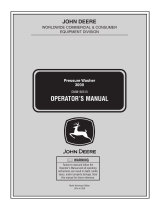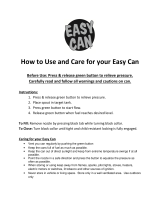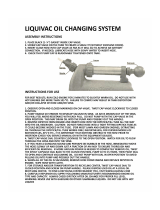Replacement Parts and Specifications - 15
REPLACEMENT PARTS AND SPECIFICATIONS
Service Literature
If you would like a copy of the Parts Catalog or Technical Manual
for this machine call (888) 228-3068 or contact your local dealer.
Please provide the model and serial numbers as recorded on the
Product Identification page.
Parts
We recommend John Deere quality parts and lubricants, available
at your John Deere dealer.
Part numbers may change - use part numbers listed below when
you order. If a number changes, your dealer will have the latest
number.
When you order parts, your John Deere dealer needs your
machine model and revision number. He may also need your
engine Model and serial number. These are the numbers that you
recorded in Product Identification.
Part Numbers
PumpSaver . . . . . . . . . . . . . . . . . . . . . . . . . . . . . . . . . . . . . .6039
O-Ring Maintenance Kit . . . . . . . . . . . . . . . . . . . . . . . .196002GS
Water Inlet Screen . . . . . . . . . . . . . . . . . . . . . . . . . . . . .B2384GS
John Deere Turf Gard Engine Oil . . . . . . . . . . . . . .Contact Dealer
Fuel Stabilizer . . . . . . . . . . . . . . . . . . . . . . . . . . . . . . . . . . . .5041
Air Cleaner . . . . . . . . . . . . . . . . . . . . . . . . . .LG491588JD or 5043
Resistor Spark Plug . . . . . . . . . . . . . . . . . . . . . . . . . . . . .M78543
Long Life Platinum Spark Plug . . . . . . . . . . . . . . . . . . . . . . .5066
(Part numbers are subject to change without notice. Part
numbers may be different outside the U.S.A.)
Performance and reliability of this machine may be adversely
affected by use of unauthorized accessories. The use of
unauthorized accessories or other alterations to the machine
voids the warranty.
Specifications
Engine Technical Information
This is a single cylinder, overhead valve(OHV), air cooled engine.
It is a low emissions engine.
In the State of California, Model 150000 engines are certified by
the California Air Resources Board to meet emissions standards
for 250 hours. Such certification does not grant the purchaser,
owner or operator of this engine any additional warranties with
respect to the performance or operational life of this engine. The
engine is warranted solely according to the product and
emissions warranties stated elsewhere in this manual.
Power Ratings
The gross power rating for individual gas engine models is labeled
in accordance with SAE (Society of Automotive Engineers) code
J1940 (Small Engine Power & Torque Rating Procedure), and
rating performance has been obtained and corrected in accordance
with SAE J1995 (Revision 2002-05). Torque values are derived at
3060 RPM; horsepower values are derived at 3600 RPM. Net
power values are taken with exhaust and air cleaner installed
whereas gross power values are collected without these
attachments. Actual gross engine power will be higher than net
engine power and is affected by, among other things, ambient
operating conditions and engine-to-engine variability. Given the
wide array of products on which engines are placed, the gas
engine may not develop the rated gross power when used in a
given piece of power equipment. This difference is due to a variety
of factors including, but not limited to, the variety of engine
components (air cleaner, exhaust, charging, cooling, carburetor,
fuel pump, etc.), application limitations, ambient operating
conditions (temperature, humidity, altitude), and engine-to-engine
variability. Due to manufacturing and capacity limitations, Briggs &
Stratton may substitute an engine of higher rated power for this
Series engine.
Pressure Washer Specifications
Outlet Pressure . . . . . . . . . . . . . . . . . . . .3300 PSI (227.5 BAR)*
Flow Rate . . . . . . . . . . . . . . . . . . . . . . 3.2 GPM (12.1 liters/min)
Water Supply Temperature . . . . . . . .Not to exceed 100°F (38°C)
Pump Oil Capacity . . . . . . . . . . . . . . . . . . . . . .12 fl. oz. (355 ml)
Engine Specifications
Bore . . . . . . . . . . . . . . . . . . . . . . . . . . . . . . 2.970 in. (75.44 mm)
Stroke . . . . . . . . . . . . . . . . . . . . . . . . . . . . . . . 2.200 in. (56 mm)
Displacement . . . . . . . . . . . . . . . . . . . . . . . . 15.24 cu in (250 cc)
Spark Plug
Type: . . . . . . . . . . . . . . . . . . . . . . . . . . . . . . M78543 or 5066
Set Gap To: . . . . . . . . . . . . . . . . . . . . . . 0.030 in. (0.76 mm)
Armature Air Gap: . . . . . . . . . . . 0.010-0.014 in. (0.25-0.36 mm)
Valve clearance with valve springs installed and piston 1/4 in.
(6 mm) past top dead center of compression stroke (check when
engine is cold).
Intake . . . . . . . . . . . . . . . . . . . . . 0.004-0.006 in. (0.10-0.15 mm)
Exhaust . . . . . . . . . . . . . . . . . . . 0.009-0.011 in. (0.23-0.28 mm)
Oil Capacity . . . . . . . . . . . . . . . . . . . . . . . .20 Ounces (0.6 Liters)
Fuel Tank Capacity . . . . . . . . . . . . . . . . . . . . .3.0 Qt. (2.84 Liters)
* This product is rated in accordance with PWMA standard
PW101 (www.pwma.org). Actual pressure at the point of
discharge may vary due to factors including: the inclusion or
exclusion of a detergent injection system; variations in engine
performance; and environmental conditions.


























